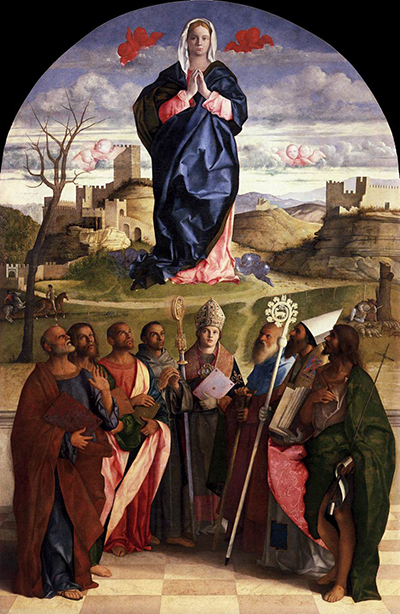The Virgin in Glory with Saints depicts a scene similar to the much-interpreted subject of the Assumption, when Mary ascends to Heaven on her death, normally watched by the Apostles.
This picture by Giovanni Bellini, however, exalts the Immaculate Conception and its glory, with a line-up (from left to right) consisting of Mark, John (the Evangelist), Luke, Francis of Assisi showing stigmata, a young Louis of Toulouse as bishop, Anthony the Great, Augustine of Hippo and John the Baptist.
The 3.5 by 2.25 metre-sized panel was painted in oil for the church of Santa Maria degli Angeli on Murano in the Venetian lagoon between 1510 and 1515, and then later housed at San Pietro Martire on the same island, before being transferred to Venice's Galerie dell'Accademia. The painting demonstrates the techniques that Giovanni Bellini had developed over his lifetime. At first influenced by the late-Gothic style of his father Jacopo, and the Padua School of his brother-in-law Andrea Mantegna, Giovanni worked mostly in tempera as a young painter, but he went on to pioneer a more natural look, and this late work shows his experience and expertise.
Born in Venice around 1426, and dying there in 1516, he re-energised Venetian art, using colours and natural light to suggest movement and emotion in his pictures. By opting for slow-drying oil paints in clear shades, Giovanni was able to produce work like Virgin in Glory With Saints in warm, deep colours and layered shadings, picking out the folds of the garments. His innovative use of light passes over the faces of the figures, and rests on the background, highlighting the towers beyond. Striking landscapes like this were another pioneering touch by Bellini, and all of these influenced the Venetian School, and in particular, his pupils Titian and Giorgione.
Today, Giovanni is the best-known member of the Bellini dynasty, although his brother Gentile was more highly-regarded during their lifetime. However, Giovanni was always ready to take on new challenges, and indeed, a slightly-earlier work by Lorenzo Lotto, Asolo Altarpiece, shows him as an older man, still learning from younger artists. This willingness to question and absorb new ideas has ensured that he is remembered and revered as a Renaissance artist today, and that paintings like this still have much to offer us.




